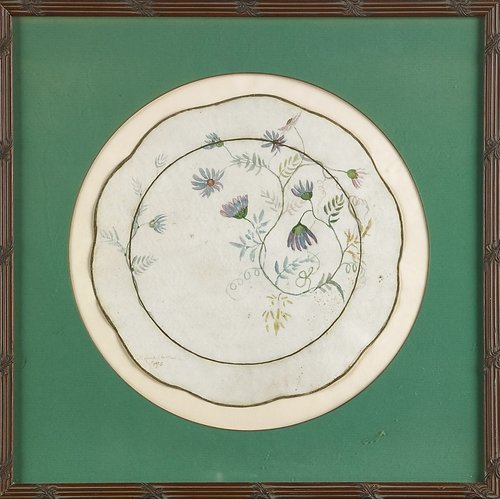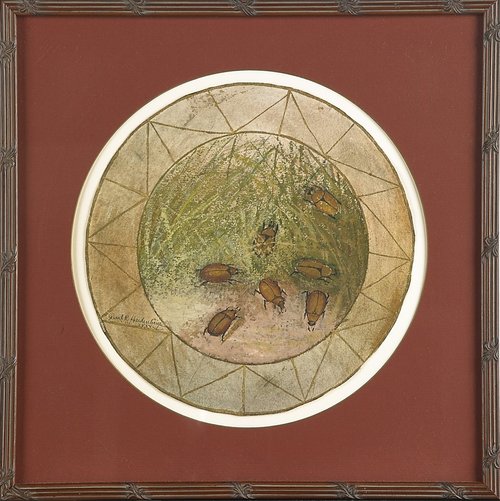
Hardenbergh Art
The Artwork of Gerard Rutgers Hardenbergh
For more information on Hardenbergh, visit our exhibit page.
Scroll to the bottom to see Hardenbergh’s Plates.
Pair of Woodcock, 1881

Pair of Woodcock, 1881
Gerard Rutgers Hardenbergh (1856–1915)
Watercolor on paper
Signed, lower left: “GERARD R. HARDENBERGH / 1881”
Collection of Ed King
American Woodcocks (Scolopax minor) are a small shorebird species found in the eastern half of North America. Unlike other kinds of shorebirds, woodcocks mainly live in wooded areas, hence their nicknames “timberdoodle,” “bogsucker,” “night partridge,” and many more depending on the location.
Thanks to conservation efforts, the population density of these birds is on the rise.
Inland Creek

Inland Creek
Gerard Rutgers Hardenbergh (1856–1915)
Watercolor on paper
Signed, lower left: “G.R. Hardenbergh”
Collection of Ed King
Wave and Sand Dunes, 1903

Wave and Sand Dunes, 1903
Gerard Rutgers Hardenbergh (1856–1915)
Watercolor on paper
Signed lower left: “GERARD R. HARDENBERGH / 1903”
Collection of Ed King
Coastal sand dunes are found on any beach with a large enough amount of sand and wide enough space. These dunes provide habitats for flora and fauna and can minimize the effects of coastal storms.
Hanging Mallard, 1906

Hanging Mallard, 1906
Gerard Rutgers Hardenbergh (1856–1915)
Oil on canvas
Signed, lower left: “G.R. HARDENBERGH / 1906”
Collection of Ed King
Mallards, also known as wild ducks (Anas platyrhrnchos), are found on every continent except for Antarctica. Unlike many other members of the waterfowl family, these birds are considered invasive species in some areas.
The more colorful birds are male while the mostly brown mallards are female.
Woodcock

Woodcock
Gerard Rutgers Hardenbergh (1856–1915)
Oil on canvas
Signed, lower left: “G.R. HARDENBERGH”
Collection of Patricia H. Burke
American Woodcocks (Scolopax minor) are a small shorebird species found in the eastern half of North America. They mainly live in wooded areas.
Road to New Brunswick, NJ, with St. James Methodist Church and St. Peter’s Catholic Church, 1897

Road to New Brunswick, NJ, with St. James Methodist Church and St. Peter’s Catholic Church, 1897
Gerard Rutgers Hardenbergh (1856–1915)
Watercolor on paper
Signed, lower left: “GR Hardenbergh / 1897”
Collection of Patricia H. Burke
Born in New Brunswick, NJ in 1856, Hardenbergh would split his life between there and the shore and continued to conduct his work there throughout his life when he was not at the shore. He maintained his New Brunswick studios on Neilson and later George Street. To learn more about Hardenbergh’s life in New Brunswick, visit the main page for this online exhibit.
Trout

Trout
Gerard Rutgers Hardenbergh (1856–1915)
Oil on canvas
Collection of Patricia H. Burke
“Trout” is the generic name for numerous types of fish that live in freshwater areas. They have been caught for a long time due to their benefits for humans as food and because of how easy they are to fish.
Edge of Herbert's Creek with Marsh Hibiscus

Edge of Herbert’s Creek with Marsh Hibiscus
Gerard Rutgers Hardenbergh (1856–1915)
Watercolor on paper
Collection of Robert M. Applegate Jr.
Also known as swamp rosemallow or swamp hibiscus, the Marsh Hibiscus in this painting grows best in wet and humid conditions and grows best in the southeast United States.
Trail Along Beaver Dam Creek

Trail Along Beaver Dam Creek
Gerard Rutgers Hardenbergh (1856–1915)
Watercolor on paper
Signed, lower left: “HARDENBERGH”
Collection of Robert M. Applegate Jr.
Beaver Dam Creek in Point Pleasant is between the Point Pleasant Canal to the south and Metedeconk River to the north.
Mallards in the Creek

Mallards in the Creek, 1914
Gerard Rutgers Hardenbergh (1856–1915)
Watercolor on paper
Signed: “GERARD R. HARDENBERGH / 1914”
Collection of Robert M. Applegate Jr.
Mallards, also known as wild ducks (Anas platyrhrnchos), are found on every continent except for Antarctica.
Snipe, 1882

Snipe, 1882
Gerard Rutgers Hardenbergh (1856–1915)
Watercolor
Signed, lower left: “GR HARDENBERGH / 1882'“
Collection of the Van Nostrand Family
Watercolor
“Snipe” is the general name for a few birds in the Scolopacidae family. Hardenbergh was likely looking at Wilson’s Snipes, as they make their home throughout North America. These birds are mostly found in marshy areas and are related to woodcocks.
While not critically endangered, these birds are affected by habitat destruction.
Golden Rod, Lovelandtown Meadow, 1885

Golden Rod, Lovelandtown Meadow, 1885
Gerard Rutgers Hardenbergh (1856–1915)
Oil on canvas
Signed, lower left: “GERARD R. Hardenbergh / 1885”
Collection of the Van Nostrand Family
Lovelandtown was settled in current day Point Pleasant at the turn of the nineteenth century.
Quail, c. 1900

Quail, c. 1900
Gerard Rutgers Hardenbergh (1856–1915)
Oil on canvas
Signed, lower left: “G.R HARDENBERGH”
Collection of the Van Nostrand Family
“Quail” is a general term for a variety of different mid-sized birds. Most quail in the Americas make their home in Central and Southerner America, but the Northern bobwhite can be found on the East Coast of the United States.
They are mostly found in the woodlands and are affected by habitat loss, to the point where they are “near-threatened” according to the International Union for Conservation of Nature.
Bay Head Yacht Club with the Old Yacht Club in the Background

Bay Head Yacht Club with the Old Yacht Club in the Background
Gerard Rutgers Hardenbergh (1856–1915)
Watercolor on paper
Signed, lower left: “G.R. HARDENBERGH / 1899”
Collection of the Van Nostrand Family
Over the course of his life, Hardenbergh had three residences in Bay Head: the houseboat he named Pelican, a home on West Lake Avenue, and finally his wifes’ home on Lake Avenue.
Learn more about Hardenbergh’s time at Bay Head on the main page for this online exhibit.
Raritan River from Sonomon's Hill, New Brunswick, NJ, 1894

Raritan River from Sonomon's Hill, New Brunswick, NJ, 1894
Gerard Rutgers Hardenbergh (1856–1915)
Watercolor on paper
Signed, bottom center: “Gerard R. Hardenbergh / 1894”
Collection of the Van Nostrand Family
Sonomon’s Hill is now the location of the Antilles athletic field on the Rutgers Douglass Campus.
Bevy of Quail, c. 1900
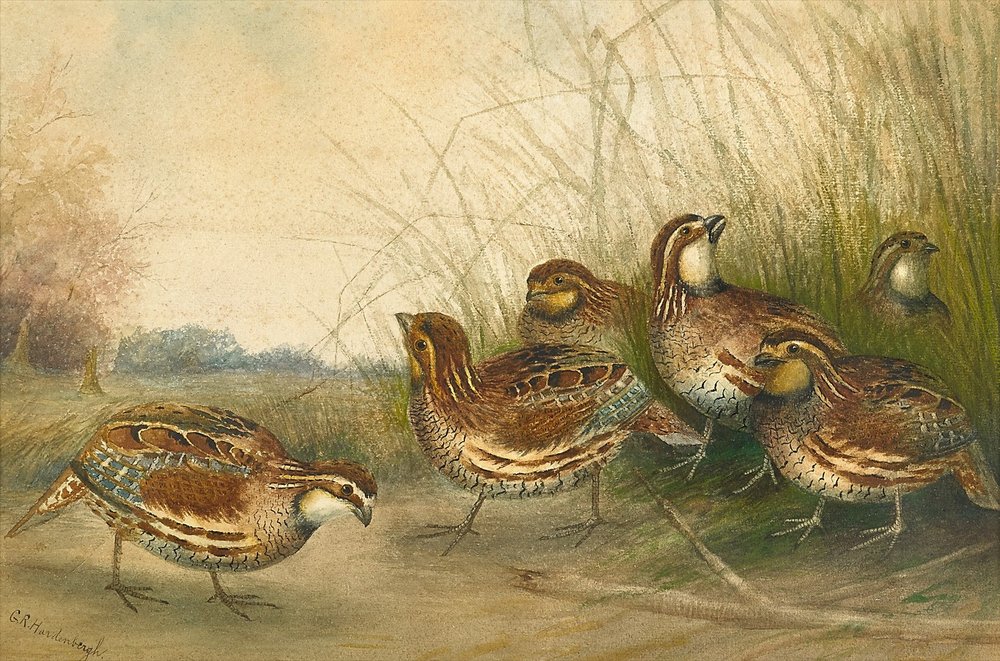
Bevy of Quail, c. 1900
Gerard Rutgers Hardenbergh (1856–1915)
Watercolor on paper
Signed, lower left: “GR. Hardenbergh”
Collection of the Van Nostrand Family
“Quail” is the general term for many mid-sized birds. Most quail in the Americas make their home in Central and Southern America, but the Northern bobwhite can be found on the East Coast of the United States.
Two Woodcock, 1894

Two Woodcock, 1894
Gerard Rutgers Hardenbergh (1856–1915)
Watercolor
Signed, lower left: “Gerard R. Hardenbergh / 1894”
Collection of the Van Nostrand Family
American Woodcocks (Scolopax minor) are a small shorebird species found in the eastern half of North America. They mainly live in wooded areas.
Three Woodcock, c. 1900

Three Woodcock, c. 1900
Gerard Rutgers Hardenbergh (1856–1915)
Watercolor
Signed, lower left: “G.R. HARDENBERGH”
Collection of the Van Nostrand Family
American Woodcocks (Scolopax minor) are a small shorebird species found in the eastern half of North America. They mainly live in wooded areas.
Marsh Hawk on Quail, 1914

Marsh Hawk on Quail, 1914
Gerard Rutgers Hardenbergh (1856–1915)
Watercolor on paper
Signed, lower left: “GERARD R. HARDENBERGH / 1914”
Collection of the Van Nostrand Family
Marsh hawks are found throughout the United States, Canada, and Central America and are larger than other hawks found in the States. While called “marsh” hawks, they are not confined to the shorelines or wetlands like other birds that Hardenbergh painted.
Chadwick House, 1904

Chadwick House, 1904
Gerard Rutgers Hardenbergh (1856–1915)
Watercolor on paper
Signed, lower left: “GR HARDENBERGH / 1904”
Collection of the Van Nostrand Family
The 1875 Atlas of the New Jersey Coast includes information that William P. Chadwick had made “many improvements” to his hotel to meet “...the demands of the times, such as a good supply of boats, decoys, fishing tackles, having also his own cattle, poultry, and an ice-house. The house can accommodate about fifty persons.”
Chadwick House in Autumn, 1907
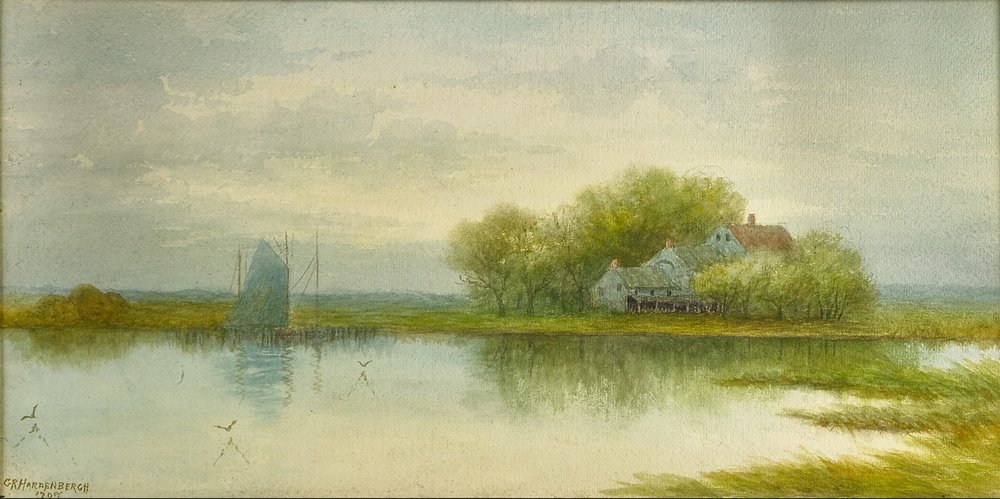
Chadwick House in Autumn, 1907
Gerard Rutgers Hardenbergh (1856–1915)
Watercolor on paper
Signed, lower left: “GR HARDENBERGH, 1907”
Collection of the Van Nostrand Family
See previous painting for more information on Chadwick House.
Hardenbergh's Dog, Nip, on Point c. 1900

Hardenbergh’s Dog, Nip, On Point, c. 1900
Gerard Rutgers Hardenbergh (1856–1915)
Oil on canvas
Signed, lower left quadrant: “GR HARDENBERGH”
Collection of the Van Nostrand Family
Hardenbergh did several paintings of his dogs. Nip, seen here, was his most famous, as he was featured in the 1901 Daily Times article, “Mr. Hardenbergh and Nip, Writer Tells of the Close Friendship Between Artist and Dog.” The article recounted that, “For more than 20 years now these two have been inseparable companions and are now to be bound together on Mr. Hardenbergh’s house boat on Barnegat Bay, near Bay Head...During all the years Mr. Hardenbergh has owned the dog they have been separate for only one night.” When Nip died a few months later a marble tombstone was erected at Ortley in his memory.
Hanging Green-winged Teal, 1896

Hanging Green-winged Teal, 1896
Gerard Rutgers Hardenbergh (1856–1915)
Watercolor on paper
Signed, lower left: “G.R. Hardenbergh / 1896”
Collection of the Van Nostrand Family
Green-winged Teals are ducks found in North America. They are migratory birds and are commonly seen in wetlands, but can be found in tundras and meadows. You’ll often find these birds in New Jersey during the winter months.
Hardenbergh's Sky, Sunset over Lovelandtown Meadow, 1901

Hardenbergh's Sky, Sunset over Lovelandtown Meadow, 1901
Gerard Rutgers Hardenbergh (1856–1915)
Watercolor on paper
Signed, lower left: “GR Hardenbergh / 1901”
Collection of the Van Nostrand Family
Lovelandtown was settled in current day Point Pleasant at the turn of the nineteenth century.
Rabbit in Snow, High Hill, Lovelandtown, c. 1900

Rabbit in Snow, High Hill, Lovelandtown, c. 1900
Gerard Rutgers Hardenbergh (1856–1915)
Watercolor on paper
Signed, lower left: “G.R. HARDENBERGH”
Collection of the Van Nostrand Family
Lovelandtown was settled in current day Point Pleasant at the turn of the nineteenth century.
Herbert's Homestead with Salt Hay & Loveland's Dock with Sailboat, 1891

Herbert's Homestead with Salt Hay & Loveland's Dock with Sailboat, 1891
Gerard Rutgers Hardenbergh (1856–1915)
Watercolor on paper
Signed, lower left: “GERARD R. HARDENBERGH / 1891”
Collection of the Van Nostrand Family
James Loveland’s dock became the site of the Bay Head Yacht Club.
Herring Island with Channel Marker, 1900

Herring Island with Channel Marker, 1900
Gerard Rutgers Hardenbergh (1856–1915)
Watercolor on paper
Signed, lower left: “GR HARDENBERGH / 1900”
Collection of the Van Nostrand Family
Herring Island is located at the head of the Metedeconk River between Bay Head and Mantoloking.
Upper Beaver Dam Creek, c.1900

Upper Beaver Dam Creek, c. 1900
Gerard Rutgers Hardenbergh (1856–1915)
Watercolor on paper
Signed, lower left: “GR HARDENBERGH”
Collection of the Van Nostrand Family
Beaver Dam Creek in Point Pleasant is between the Point Pleasant Canal to the south and Metedeconk River to the north. Today, you can walk along the boardwalk on the wetlands to try to spot some of the birds Hardenbergh once painted!
Osborn Island with Cooke Mansion and Cedar Bluff Cottage, c.1900

Osborn Island with Cooke Mansion and Cedar Bluff Cottage, c. 1900
Gerard Rutgers Hardenbergh (1856–1915)
Watercolor on paper
Signed, lower left: “GR. HARDENBERGH”
Collection of the Van Nostrand Family
Osborn Island sits in the Manasquan River.
Hay Scow on Barnegat Bay, 1900

Hay Scow on Barnegat Bay, 1900
Gerard Rutgers Hardenbergh (1856–1915)
Watercolor on paper
Signed, lower left: “G.R. HARDENBERGH”
Collection of the Van Nostrand Family
Hay Scow were small river (and lake) boats that were popular before the advent of gasoline powered boats. They helped move supplies and people around- sometimes between islands and the shore or just from one side of a river to another.
Bluejays, 1901

Bluejays, 1901
Gerard Rutgers Hardenbergh (1856–1915)
Watercolor on paper
Signed, lower left: “G.R HARDENBERGH / 1901”
Collection of the Van Nostrand Family
Blue jays (Cyanocitta cristata) are found on the East Coast of North America. You will likely find these birds in the woods and in residential areas, even around Princeton.
Israel Johnson's Homestead, with Apple Orchards Along Beaver Dam Creek, 1908

Israel Johnson's Homestead, with Apple Orchards Along Beaver Dam Creek, 1908
Gerard Rutgers Hardenbergh (1856–1915)
Watercolor on paper
Signed, lower left: “GR HARDENBERGH / 1908”
Collection of the Van Nostrand Family
Beaver Dam Creek in Point Pleasant is between the Point Pleasant Canal to the south and Metedeconk River to the north. Today, you can walk along the boardwalk on the wetlands to try to spot some of the birds Hardenbergh once painted.
Pectoral Sandpipers

Pectoral Sandpipers, 1894
Gerard Rutgers Hardenbergh (1856–1915)
Oil on canvas
Signed, lower left: “Gerard R. Hardenbergh / 1894”
Collection of the Van Nostrand Family
Pectoral sandpipers (Calidris melanotos) are small birds found mostly in the Americas but also in northern Asia. These migratory birds make their nests in the ground.
They are likely affected by global warming as they spend part of their year in the Arctic.
Sora Rail, 1894

Sora Rail, 1894
Gerard Rutgers Hardenbergh (1856–1915)
Watercolor on paper
Signed, lower left: “Gerard R. Hardenbergh / 1894”
Collection of the Van Nostrand Family
Sora rails (Porzana carolina) are small, water birds that make their home in North and Central America. They are a migratory bird that prefer to spend their time near marshes and water.
They have been affected by the ongoing loss of habitation that many wetland birds face.
Pectoral Sandpipers, c.1900

Pectoral Sandpipers, c. 1900
Gerard Rutgers Hardenbergh (1856–1915)
Oil on canvas
Signed, lower left: “GERARD R HARDENBERGH”
Collection of the Van Nostrand Family
Pectoral sandpipers (Calidris melanotos) are small birds found mostly in the Americas but also in northern Asia. These migratory birds make their nests in the ground.
Two Grouse, c.1900

Two Grouse, c. 1900
Gerard Rutgers Hardenbergh (1856–1915)
Watercolor on paper
Signed, lower left: “G.R. Hardenbergh”
Collection of the Van Nostrand Family
Grouse make up a large amount of birds that are found in forested, prairie, and tundra areas. North America hosts a wide range of grouse types and these birds are closely related to turkeys.
Grouse that mainly live in the prairies and open meadows of North America are facing difficult times with the continued loss of their habitats.
Herbert's Creek with Bay Head Sand Dunes, 1899

Herbert’s Creek with Bay Head Sand Dunes, 1899
Gerard Rutgers Hardenbergh (1856–1915)
Watercolor on paper
Signed, lower left: “G.R. HARDENBERGH / 1899”
Collection of the Van Nostrand Family
This painting shows Herbert’s Creek which was ran through the current location of the man-made Point Pleasant Canal.
Esther Loveland Kinsley recalled the creek in the 1920s, “... turtles and frogs slid from the embankments into the water as our boat glided gracefully through the smooth waters. There was no bulkheading at the time so the trees and bushes hung precariously over the banks of the canal where occasionally you would see a boy fishing. Further back from the water’s edge you could see mountains of white sand dotted with pines, cedars and pin oaks.”
Herbert's Creek with Bay Head Sand Dunes, 1895

Herbert’s Creek with Bay Head Sand Dunes, 1895
Gerard Rutgers Hardenbergh (1856–1915)
Watercolor on paper
Signed, lower left: “GERARD R. HARDENBERGH / 1895”
Collection of the Van Nostrand Family
This painting shows Herbert’s Creek, which ran through the current location of the man-made Point Pleasant Canal.
Striped Bass, 1912

Striped Bass, 1912
Gerard Rutgers Hardenbergh (1856–1915)
Oil on canvas
Signed, lower left: “G.R. HARDENBERGH / 1912”
Collection of the Van Nostrand Family
Striped bass (Morone saxatilis) are most commonly found in the Atlantic ocean around the United States. They are the state saltwater fish of New Jersey and New York and state fish of Maryland, as well as a few other states along the east coast.
Grouse, 1885

Grouse, 1885
Gerard Rutgers Hardenbergh (1856–1915)
Oil on canvas
Signed, lower left: “GR HARDENBERGH / 1885”
Collection of the Van Nostrand Family
Grouse make up a large amount of birds that are found in forested, prairie, and tundra areas. North America hosts a wide range of grouse types and these birds are closely related to turkeys.
Bay Head Beach

Bay Head Beach, 1906
Gerard Rutgers Hardenbergh (1856–1915)
Watercolor on paper
Signed, lower left: “GR HARDENBERGH / 1906”
Collection of Robert M. Applegate Jr.
Over the course of his life, Hardenbergh had three residences in Bay Head: the houseboat he named Pelican, a home on West Lake Avenue, and finally his wifes’ home on Lake Avenue. Learn more about Hardenbergh’s time at Bay Head on the main page for this online exhibit.
Sora Rail, 1882
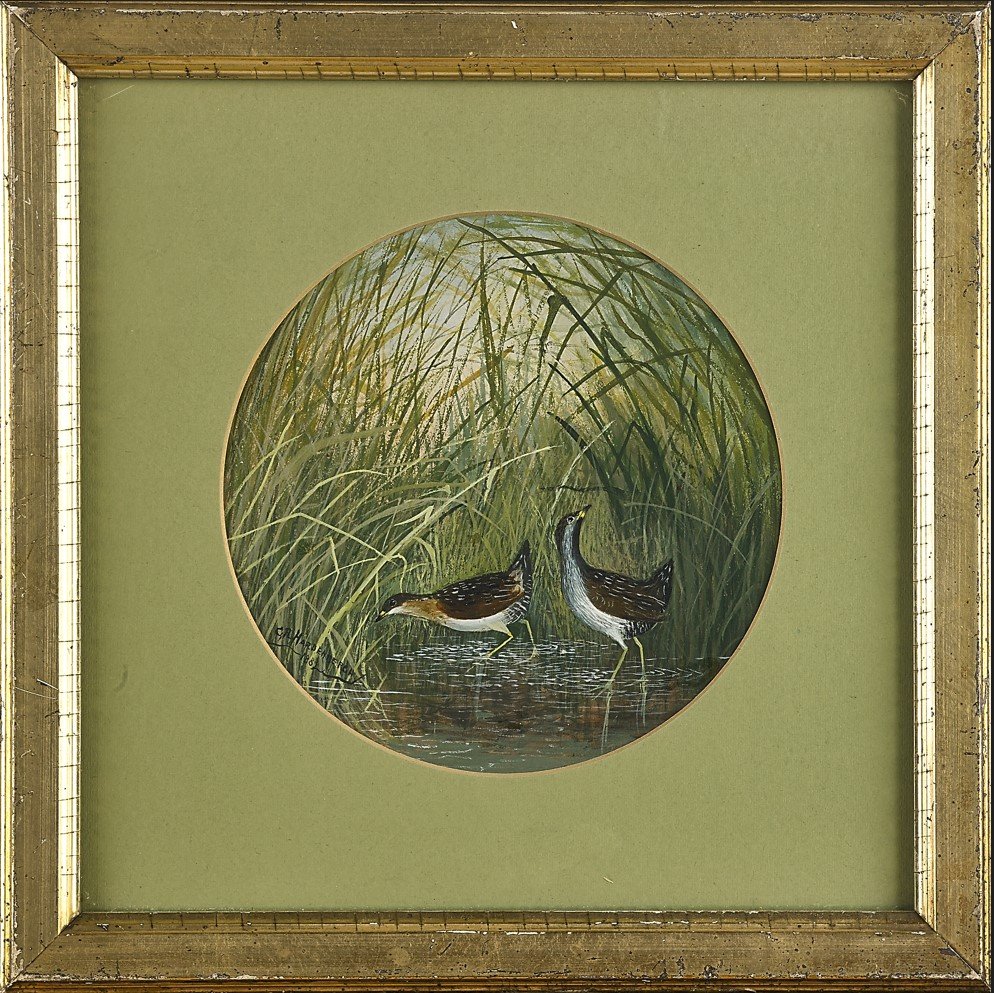
Sora Rail, 1882
Gerard Rutgers Hardenbergh (1856–1915)
Watercolor on paper
Signed, lower left: “GERARD R HARDENBERGH / 1882”
Collection of the Van Nostrand Family
Sora rails (Porzana carolina) are small water birds that make their home in North and Central America. They are a migratory bird that prefer to spend their time near marshes and water.
Hardenbergh’s Bird Playmates, 1916

Hardenbergh’s Bird Playmates, 1916
Published by Charles Scribner’s Sons
Collection of the Van Nostrand Family
Advertised as “a unique device that ought to prove to be of immense value to teachers of nature study,” this game was made up of two sets: one for land birds and one for water birds. Each came with its own background and set of birds “following with scientific exactness the colors of the living bird.” The game could counter “the chief difficulty that teachers have found in teaching children to identify birds” which was “the impossibility of bringing living birds into the classroom.” Bird Lore magazine reviewed the game stating, “It seems well designed to instruct as well as amuse…”
To see more of the images from this game, click here.
Platter, English Snipe and Ruffed Grouse
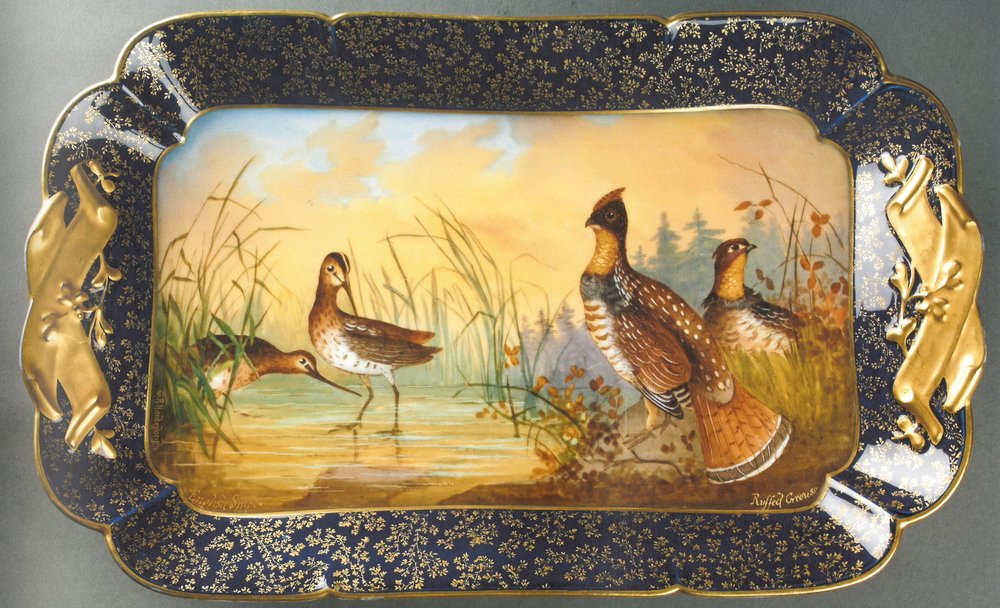
English Snipe and Ruffed Grouse, Game Bird Set Platter
Gerard Rutgers Hardenbergh (1856–1915)
Haviland & Company, Limoges, France, 1887
Ocean County Historical Society Collection, 99.48.1
Plate, Canvas-back Ducks

Canvas-back Ducks, Game Bird Set Plate
Gerard Rutgers Hardenbergh (1856–1915)
Haviland & Company, Limoges, France, 1887
Ocean County Historical Society Collection, 99.48.12
Canvas-back ducks (Aythya valisineria) are the largest diving ducks in North America. They make their homes in the prairies and wetlands of the continent and were a popular dish in the 19th century. They were endangered in the 1980s, but made a comeback a decade later and thanks to protected areas, they are no longer a concern to conservationists.
Plate, English Snipe

Game Bird Set Plate
Gerard Rutgers Hardenbergh (1856–1915)
Haviland & Company, Limoges, France, 1887
Ocean County Historical Society Collection, 99.48.7
“Snipe” is the general name for a few birds in the Scolopacidae family. These birds are mostly found in marshy areas and are related to woodcocks.
Plate, French Partridge

Game Bird Set Plate
Gerard Rutgers Hardenbergh (1856–1915)
Haviland & Company, Limoges, France, 1887
Ocean County Historical Society Collection, 99.48.5
French partridges are Red-legged partridge (Alectoris rufa) and make their home across the southwest of Europe, not just France. They have also been introduced to England as a game bird so you can find French and English partridges in southern England. They’ve even been kept as pets in New Zealand!
Plate, Killdeer Plover

Game Bird Set Plate
Gerard Rutgers Hardenbergh (1856–1915)
Haviland & Company, Limoges, France, 1887
Ocean County Historical Society Collection, 99.48.9
Killdeer plovers (Charadrius vociferus) are found throughout the Americas. They make their homes in both wetlands and in fields and consist of three subspecies. While their population is declining, it is not decreasing fast enough to be a concern to conservationists.
Plate, Reed Birds

Game Bird Set Plate
Gerard Rutgers Hardenbergh (1856–1915)
Haviland & Company, Limoges, France, 1887
Ocean County Historical Society Collection, 99.48.4
Common reed warblers (Acrocephalus scirpaceus) live in Europe, Western Asia, and Africa. Like their name suggests, they make their homes in reeds and bushes and consist of 10 subspecies.
Plate, Ruffed Grouse

Game Bird Set Plate
Gerard Rutgers Hardenbergh (1856–1915)
Haviland & Company, Limoges, France, 1887
Ocean County Historical Society Collection, 99.48.6
Grouse make up a large amount of birds that are found in forested, prairie, and tundra areas. North America hosts a wide range of grouse types and these birds are closely related to turkeys.
Plate, Sora Rail Birds

Game Bird Set Plate
Gerard Rutgers Hardenbergh (1856–1915)
Haviland & Company, Limoges, France, 1887
Ocean County Historical Society Collection, 99.48.11
Sora rails (Porzana carolina) are small, water birds that make their home in North and Central America. They are a migratory bird that prefer to spend their time near marshes and water.
Plate, Virginia Rail Birds

Game Bird Set Plate
Gerard Rutgers Hardenbergh (1856–1915)
Haviland & Company, Limoges, France, 1887
Ocean County Historical Society Collection, 99.48.2
Virginia rails (Rallus limicola) are small, water birds that make their home in North America. They make their homes in marshes and migrate to the southern United States and Central America in the winter.
Plate, Woodcock

Game Bird Set Plate
Gerard Rutgers Hardenbergh (1856–1915)
Haviland & Company, Limoges, France, 1887
Ocean County Historical Society Collection, 99.48.10
American Woodcocks (Scolopax minor) are a small shorebird species found in the eastern half of North America. They mainly live in wooded areas.
Plate, Yellowleg Snipe

Game Bird Set Plate
Gerard Rutgers Hardenbergh (1856–1915)
Haviland & Company, Limoges, France, 1887
Ocean County Historical Society Collection, 99.48.3
“Snipe” is the general name for a few birds in the Scolopacidae family. These birds are mostly found in marshy areas and are related to woodcocks.
Plate, Doe-witch Snipe

Game Bird Set Plate
Gerard Rutgers Hardenbergh (1856–1915)
Haviland & Company, Limoges, France, 1887
Ocean County Historical Society Collection, 99.48.8
“Snipe” is the general name for a few birds in the Scolopacidae family. These birds are mostly found in marshy areas and are related to woodcocks.
Plate design with Bluefish, 1899

Plate design with Bluefish, 1899
Gerard Rutgers Hardenbergh (1856–1915)
Watercolor on paper
Signed, lower left: “G.R Hardenbergh / 1899”
Collection of Patricia H. Burke
Bluefish are ocean fish found around the world, especially in tropical and subtropical areas as well as along the coasts. In North America, you can find these fish around Florida in the winter before they migrate as far north as Nova Scotia in the summer.
Plate design Shells and Seagrass

Plate Design with Shells and Seagrass
Gerard Rutgers Hardenbergh (1856–1915)
Watercolor on paper
Signed, bottom: “GR Hardenbergh”
Collection of Patricia H. Burke
Seagrass looks and acts a lot like their namesake: grass. Underground meadows full of seagrass provide shelter and food for many of the animals that call the ocean home.
Plate design with Aster, 1890

Plate Design with Aster, 1890
Gerard Rutgers Hardenbergh (1856–1915)
Watercolor on paper
Signed, lower left: “GR Hardenbergh / 1890”
Collection of the Van Nostrand Family
Most aster species are found across Eurasia but in North America you’ll usually find New England aster (Symphyotrichum novae-angliae) and New York aster (Symphyotrichum novi-belgii). These perennial flowers are great for all types of gardens and for the local pollinators.
Plate design with Butterflies: Eastern Tailed Blue, Clouded Sulphur, Dainty Sulphur, Milbert’s Tortoiseshell, 1888

Plate design with Butterflies: Eastern Tailed Blue, Clouded Sulphur, Dainty Sulphur, Milbert’s Tortoiseshell, 1888
Gerard Rutgers Hardenbergh (1856–1915)
Watercolor on paper
Signed, center left: “GR Hardenbergh / 1888”
Collection of the Van Nostrand Family
Eastern Tailed Blue, Clouded Sulphur, Dainty Sulphur, Milbert’s Tortoiseshell
Butterflies are found around the world and are often migratory species. The four butterflies painted here are the Eastern Tailed-Blue, a small butterfly from the east of North America; Clouded Sulphur, found across North America in open spaces; Dainty Sulphur, a rare type of North American butterfly; and Milbert’s Tortoiseshell, making their homes in Canada and the United States’ woodlands.
Plate design with May Beetles, 1888

Plate Design with May Beetles, 1888
Gerard Rutgers Hardenbergh (1856–1915)
Watercolor on paper
Signed, center left: “Gerard R Hardenbergh / 1888”
Collection of the Van Nostrand Family
Also known as June bugs and July beetles, these small nocturnal bugs are found across North and South America.
Plate design with Dragonflies: Blue-fronted Dancer, Broad-winged Damselfly, Widow Skimmer, 1888

Plate design with Dragonflies: Blue-fronted Dancer, Broad-winged Damselfly, Widow Skimmer, 1888
Gerard Rutgers Hardenbergh (1856–1915)
Watercolor on paper
Signed, center left: “Gerard R Hardenbergh / 1888”
Collection of the Van Nostrand Family
Dragonflies are found around the world, usually in tropical areas but can be found in temperate regions as well. As wetlands continue to be threatened, so too are many populations of dragonflies.
Plate design with Red-legged Grasshoppers, 1888

Plate design with Red-legged Grasshoppers, 1888
Gerard Rutgers Hardenbergh (1856–1915)
Watercolor on paper
Signed, center left: “Gerard R Hardenbergh / 1888”
Collection of the Van Nostrand Family
Red-legged grasshoppers (melanoplus femurrubrum) are found across North America and prefer grasslands or areas with thick vegetation.
Plate design with Cherry Tree, c.1890

Plate Design with Cherry Tree, c. 1890
Gerard Rutgers Hardenbergh (1856–1915)
Watercolor on paper
Collection of the Van Nostrand Family
The cherry trees we know originated in Europe, western Asia, and northern Africa before coming to North America. Most of the United States cherry production comes from the western and central states as well as New York.
Plate design with Grapevine, c.1890

Plate Design with Grapevine, c. 1890
Gerard Rutgers Hardenbergh (1856–1915)
Watercolor on paper
Collection of the Van Nostrand Family
Most grapes thrive in the Northern Hemisphere, with most species from North America and eastern Asia.
Plate design with Flying Locust, 1888
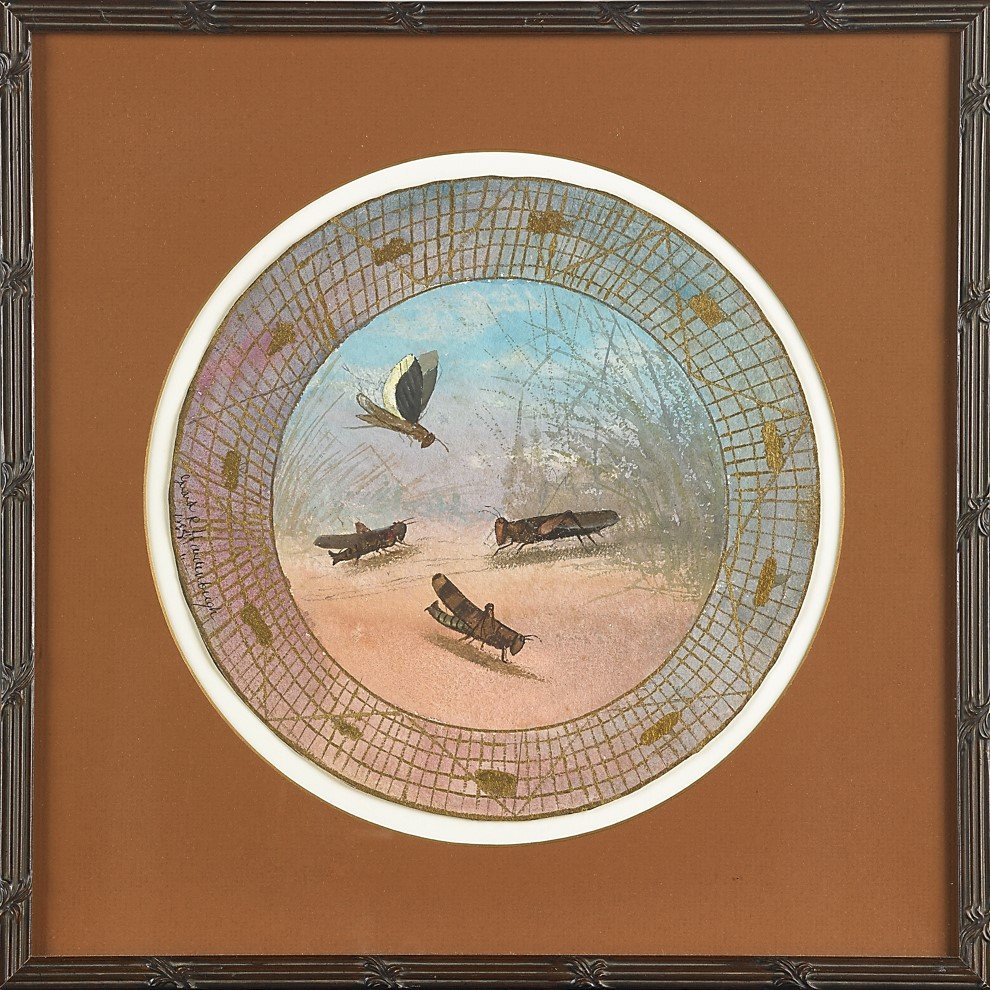
Plate Design with Flying Locust, 1888
Gerard Rutgers Hardenbergh (1856–1915)
Watercolor on paper
Signed, along left edge: “Gerard R Hardenbergh / 1888”
Collection of the Van Nostrand Family
Locusts look a lot like grasshoppers, but you can tell the two species apart by how they act. After a drought, they are known to have population booms and start swarms that can completely destroy crops in a short period of time.


























































